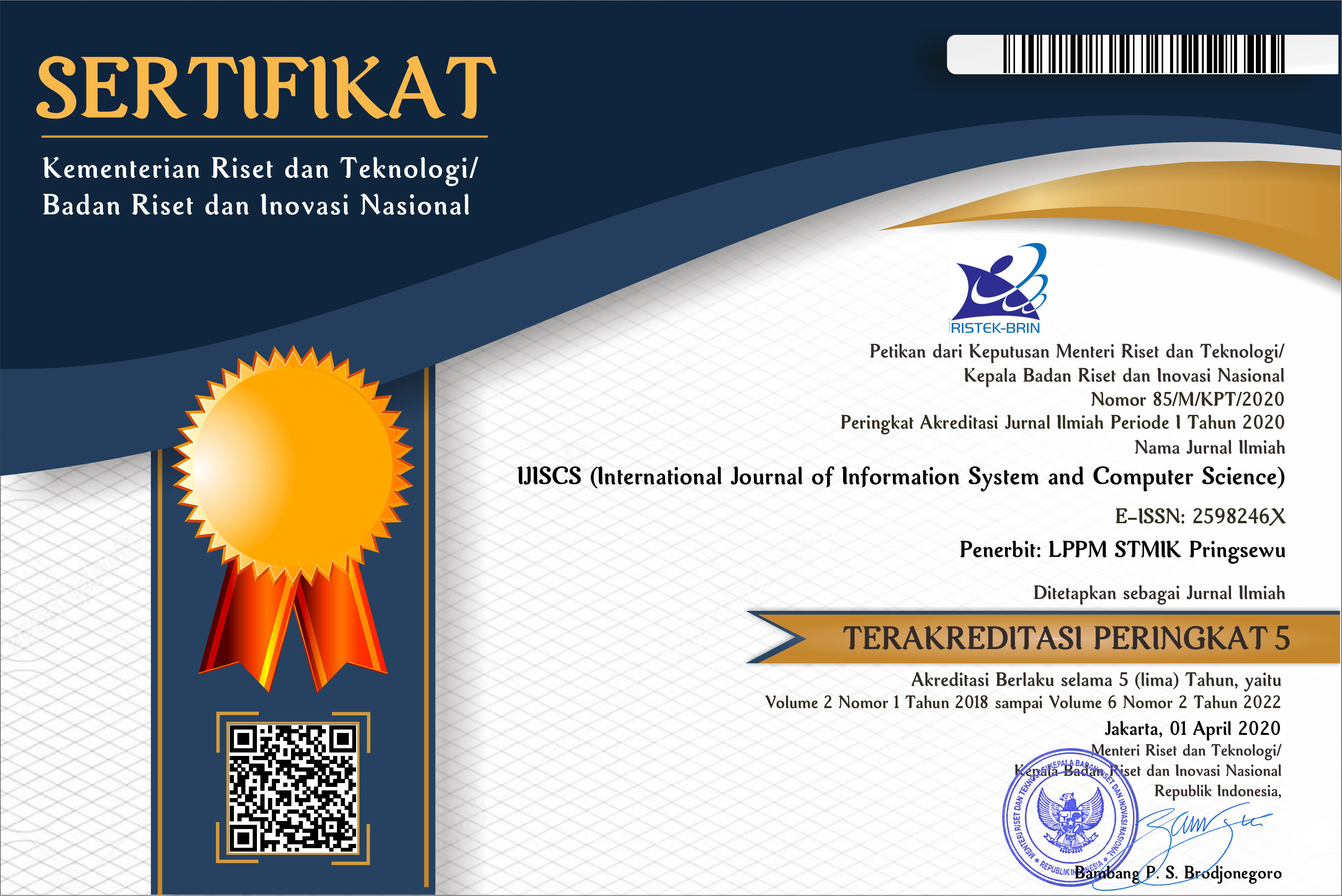THE COMPARISON OF SIMPLE ADDITIVE WEIGHTING AND TOPSIS TO MEASURE THE PERFORMANCE OF THE VILLAGE HEAD IN PRINGSEWU REGENCY
(1) Department of Information System, STMIK Pringsewu, Pringsewu, Lampung
(2) Department of Information System, STMIK Pringsewu, Pringsewu, Lampung
(3) Department of Information System, STMIK Pringsewu, Pringsewu, Lampung
(4) Department of Information System, STMIK Surya Intan, North Lampung, Lampung
 Corresponding Author
Corresponding Author
Abstract
The village has an important role in improving the national economy. A developed village will have a good impact on people's lives, both from the economy and the welfare of the community. The village head has an important role in running the government in rural areas. One of the indicators for evaluating the success rate of development and prosperity of an area is the success of a village itself so that the village or village has an important role in the process of improving development. With special autonomy regarding village development, the role of the village head becomes central and becomes the driving force for village development. To find out how well the village head is performing, it is necessary to have a breakthrough in measuring the village head's performance index in Pringsewu Regency. In measuring the performance of the Village Head, the criteria and weighting of the Simple Additive Weighting and TOPSIS methods are used. The sample was tested using eighteen villages spread across nine sub regency in the Pringsewu Regency. The application of two methods of decision support systems using Simple Additive Weighting and TOPSIS in measuring the index of Village Heads in Pringsewu Regency can trigger an increase in the performance of village heads to build the villages based on predetermined criteria. Of the eighteen alternatives tested, the highest value was A16 with a value of 0.8901508.
Keywords
References
P. Menteri, Peraturan Menteri Dalam Negeri Republik Indonesia Nomor 82 Tahun 2015 Tentang Pengangkatan Dan Pemberhentian Kepala Desa. 2015.
D. Purnamasari, Undang Undang Republik Indonesia Nomor 6 Tahun 2014 Tentang Desa. Sinar Grafika, 2017.
A. Romadoni, “Sistem Pendukung Keputusan Seleksi Pemilhan Calon Kepala Desa Berbasis Web,” Skripsi UMS, hal. 1–15, 2014.
A. Andoyo, M. Muslihudin, dan N. Y. Sari, “Pembuatan Model Penilaian Indeks Kinerja Dosen Menggunakan Metode Fuzzy Multi Attribute Decision Making ( FMADM ) ( Studi : PTS di Provinsi Lampung ),” Pros. Semin. Nas. Darmajaya, vol. 17, no. 2, hal. 195–205, 2017.
F. Rinjani, M. Muslihudin, dan F. Satria, “Aplikasi Berbasis Website sebagai Media Pengukuran Kinerja Kepala Pekon di Kecamatan Pagelaran Pringsewu,” in Prosiding Seminar Nasional Darmajaya, 2018, hal. 67–74.
S. Mukodimah, M. Muslihudin, dan A. Maseleno, “Implementasi Weighted Product Untuk Mengukur Indeks Kinerja Kepala Desa Di Kecamatan Pringsewu,” in KNSI 2018, 2018, hal. 587–592.
S. Kusumadewi, S. Hartati, A. Harjoko, dan Retanto Wardoyo, Fuzzy Multi-Attribute Decision Making (Fuzzy MADM). Yogyakarta: Graha Ilmu, 2013.
E. Y. Anggraeni, “Penerapan Metode Fuzzy Simple Additive Waighting ( FSAW ) Dalam Penentuan Perankingan Sekolah Menengah Kejuruan ( SMK ) Di Kabupaten Pringsewu,” SEMNASTEKNOMEDIA, vol. 5, no. 1, hal. 31–37, 2017.
I. Widaningrum, “Evaluasi Kinerja Dosen Menggunakan Metode Fuzzy Multi-Attribute Decision Making (FMADM) Dengan Pengembangan (Studi Kasus: Universitas Muhammadiyah Ponorogo),” SEMNASTEKNOMEDIA, vol. 1, no. 2, hal. 61–66, 2013.
T. E. Erkan dan B. D. Rouyendegh, “Curriculum Change Parameters Determined by Multi Criteria Decision Making (MCDM),” Procedia - Soc. Behav. Sci., vol. 116, no. 1987, hal. 1744–1747, 2014.
J. Y. Pak, V. V. Thai, dan G. T. Yeo, “Fuzzy MCDM Approach for Evaluating Intangible Resources Affecting Port Service Quality,” Asian J. Shipp. Logist., vol. 31, no. 4, hal. 459–468, 2015.
R. E. Setyani dan R. Saputra, “Flood-prone Areas Mapping at Semarang City by Using Simple Additive Weighting Method,” in Procedia - Social and Behavioral Sciences, 2016, hal. 378–386.
M. Aghajani Mir et al., “Application of TOPSIS and VIKOR improved versions in a multi criteria decision analysis to develop an optimized municipal solid waste management model,” J. Environ. Manage., vol. 166, 2016.
Z. Yue, “TOPSIS-based group decision-making methodology in intuitionistic fuzzy setting,” Inf. Sci. (Ny)., vol. 277, 2014.
S. K. Patil dan R. Kant, “A fuzzy AHP-TOPSIS framework for ranking the solutions of Knowledge Management adoption in Supply Chain to overcome its barriers,” Expert Syst. Appl., vol. 41, no. 2, 2014.
E. Roszkowska dan T. Wachowicz, “Application of fuzzy TOPSIS to scoring the negotiation offers in ill-structured negotiation problems,” Eur. J. Oper. Res., vol. 242, no. 3, 2015.
S. H. Mousavi-Nasab dan A. Sotoudeh-Anvari, “A comprehensive MCDM-based approach using TOPSIS, COPRAS and DEA as an auxiliary tool for material selection problems,” Mater. Des., vol. 121, 2017.
S. NǍdǍban, S. Dzitac, dan I. Dzitac, “Fuzzy TOPSIS: A General View,” in Procedia Computer Science, 2016, vol. 91.
Article Metrics
Abstract View : 205 times
: 205 times Download : 58 times
Download : 58 times
DOI: 10.56327/ijiscs.v4i3.937
Refbacks
- There are currently no refbacks.






